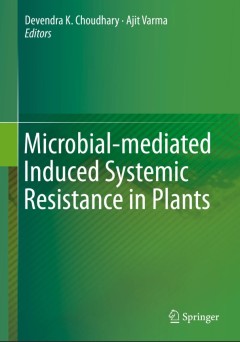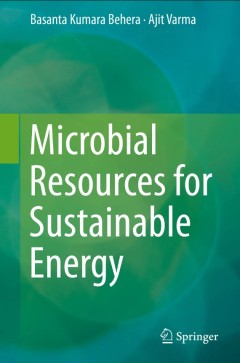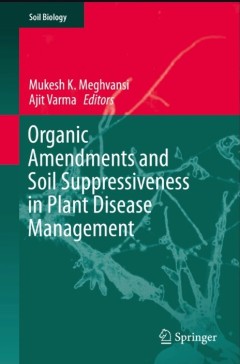Filter by

Heavy Metal Contamination of Soils Monitoring and Remediation
Following a description of the various sources and factors influencing the contents of heavy metal pollution in post-catastrophic and agricultural soils, subsequent chapters examine soil enzymes and eggs as bio-monitors, lead adsorption, the effects of arsenic on microbial diversity, and the effects of Mediterranean grasslands on abandoned mines. A third section focuses on the adaptation strate…
- Edition
- -
- ISBN/ISSN
- 978-3-319-14525-9
- Collation
- XIX, 497
- Series Title
- -
- Call Number
- 630 HEA

Plant-Growth-Promoting Rhizobacteria (PGPR) and Medicinal Plants
This book describes the various applications of microorganisms in improving plant growth, health and the efficiency of phytochemical production. The chapters trace topics such as the role of PGPRs in improving salt stress and heavy metal tolerance in plants; the prevention and control of plant diseases; boosting soil fertility and agriculture productivity; the induction of secondary metabolite…
- Edition
- 1
- ISBN/ISSN
- 978-3-319-13401-7
- Collation
- XV, 442
- Series Title
- Soil Biology
- Call Number
- 631.8 EGA p

Plant-Microbe Interaction: An Approach to Sustainable Agriculture
Pertanian berkelanjutan melibatkan perancangan sistem pertanian yang menggunakan alam sebagai model. Pada sebagian besar ekosistem alami, semakin besar keanekaragamannya, semakin tahan ekosistem tersebut terhadap perubahan dan semakin mampu pulih dari gangguan. Dalam ekosistem pertanian atau yang disebut agroekosistem (AES), gangguan jauh lebih sering terjadi, teratur, dan intens. Konsep ekolog…
- Edition
- -
- ISBN/ISSN
- 978-981-10-2854-0
- Collation
- -
- Series Title
- -
- Call Number
- 577.85 CHO p

Microbial-mediated Induced Systemic Resistance in Plants
With a focus on food safety, this book highlights the importance of microbes in sustainable agriculture. Plants, sessile organisms that are considered as primary producers in the ecosystem and communicate with above- and below-ground communities that consist of microbes, insects, and other vertebrate and invertebrate animals, are subjected to various kinds of stress. Broadly speaking, these can…
- Edition
- 1
- ISBN/ISSN
- 978-981-10-0387-5
- Collation
- X, 226
- Series Title
- -
- Call Number
- -

Microbial Resources for Sustainable Energy
This book sheds new light on how microbes can be used as effective and sustainable resources to produce green energy in the form of biogas, algal diesel, ethanol, hydrogen and direct electricity. It discusses topics such as microbial energy conversion technologies, including ethanol production by microbial catalytic reaction, biomethanization, biodiesel from microalgae, microbial fuel cells, an…
- Edition
- 1
- ISBN/ISSN
- 978-3-319-33776-0
- Collation
- XIX, 280
- Series Title
- -
- Call Number
- -

Biocontrol of Lepidopteran Pests : Use of Soil Microbes and their Metabolites
This volume describes the various applications of entomopathogenic soil microorganisms in the management and control of the devastating lepidopteran pest. An introduction describes the insecticidal properties of viruses, bacteria, fungi, nematodes and their metabolites, as well as their applications in the context of crop improvement. Subsequent chapters focus on topics such as insecticidal pro…
- Edition
- -
- ISBN/ISSN
- -
- Collation
- -
- Series Title
- -
- Call Number
- 579

Organic Amendments and Soil Suppressiveness in Plant Disease Management
This book provides a timely review of concepts in plant disease management involving microbial soil suppressiveness and organic amendments. Topics discussed include the impact of suppressive soils on plant pathogens and agricultural productivity, the enhancement of soil suppressiveness through the application of compost and the development of disease suppressive soils through agronomic manag…
- Edition
- -
- ISBN/ISSN
- 978-3-319-23075-7
- Collation
- -
- Series Title
- -
- Call Number
- 631.4 ORG
 Computer Science, Information & General Works
Computer Science, Information & General Works  Philosophy & Psychology
Philosophy & Psychology  Religion
Religion  Social Sciences
Social Sciences  Language
Language  Pure Science
Pure Science  Applied Sciences
Applied Sciences  Art & Recreation
Art & Recreation  Literature
Literature  History & Geography
History & Geography